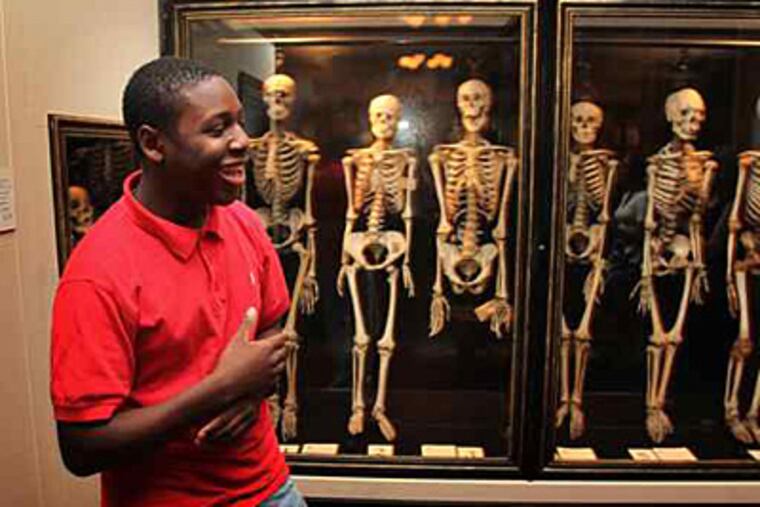A youthful remedy
Two dozen young people bring a dose of verve to the august College of Physicians in a program meant to multiply minorities in the health sciences.

The former old boys club on 22d Street, replete with majestic columns, marble rotunda, grand staircase, and a beaux arts exterior protected by a wrought-iron gate, is imposing but not impenetrable.
At 16, Faith Konate of South Philadelphia already has a foot in the ancient oak door.
An 11th grader at Masterman High, Konate is among 24 young people from "under-resourced" neighborhoods who were handpicked for a novel project at the revered College of Physicians, on South 22d Street.
The "college" is not a school at all, but a professional association founded 223 years ago. It houses the Mütter Museum, which showcases medical specimens and oddities, a renowned library, and has 1,400 professional members, called Fellows.
As the oldest medical society in the United States, the college once epitomized white, male, Anglo-Saxon privilege. This project is a three-year program aimed at widening the circle, preparing students like Konate - racial and ethnic minorities - for careers in the health sciences.
Plucked from the city and its suburbs, where they still attend public, private, or parochial schools, these 11th graders are the college's first-ever Junior Fellows.
One day they may be epidemiologists, dentists, nurses, or health-care administrators, and when that happens, they may flip back through the journals they kept at the college and give thanks to the foresight of people like George Wohlreich, the college CEO, and Nicholas and Athena Karabots, local philanthropists who were smart enough to see Wohlreich's $800,000 dream as doable, and generous enough to fund it.
But for now they are curious specimens themselves, these junior fellows, prowling the library stacks and the bone room with such enthusiasm and unabashed joy that the staff here have come to call them the Karabots Kids.
This is not a premed program, says Jacqui Bowman, who works with the junior fellows. Yes, she reviews the students' report cards and arranges for tutoring in their weaker subjects. And true, the students were taught mnemonic devices that will likely come in handy when they take the PSATs in the fall.
But the Karabots Junior Fellows program is not aimed at medical school admission. It seeks to open the eyes of young people to the range of career opportunities in health care - in part because as recently as 2007, researchers at Johns Hopkins University found that underrepresentation of racial and ethnic minorities in the health-care professions resulted in a diminished standard of care for minority patients.
When Wohlreich, a practicing psychiatrist, came on as the college's CEO four years ago, he argued that the institution known as the "birthplace of American medicine" must take an active role in correcting those disparities.
Karabots, a self-made businessman, identified immediately with the idea. He entered the world of work as a printer for Walter Annenberg's TV Guide and went on to amass a fortune and endow a foundation.
Wohlreich says the college is using all its resources - its research arm, library, museum, and 1,400 fellows - to expose junior fellows to the heritage and ideals of medical science.
"It is," he says, "the passing of the torch."
The Karabots Kids started in August 2009 and are at the midpoint of their three-year program. Already they've created a new museum exhibition called "Splendid Skulls," and a series of educational and extremely comical videos (youtube.com/collegeofphysicians) showing the influence of exercise, smoking, and fast food on health.
On a trip to Drexel University, they learned to take blood pressure and pulse on the same simulated patients that medical students use. In Rittenhouse Square, landscape architect Michael Nairn explained how sewage control improved public health. A physical therapist demonstrated the keys to break-dancing without breaking bones. An archaeologist led a cooking class, using an 18th-century menu to explain how, by studying old animals' innards, we learn what foods humans ate, how they cooked, and how that influenced human evolution.
"And she showed us how people cooked asparagus so it would taste like peas," Konate said, "because peas were a delicacy."
Students are paired with mentors in their future fields, even if their choices seem fluid. Konate went from psychiatry to epidemiology, gynecology, physical therapy, linguistics, and back - all the while paired with college fellow Carla Rodgers, a forensic psychiatrist.
Gabrielle Smith, an intense 17-year-old from Mount Airy who attends Girls High, aspires to a career in cardiology, and her mentor is college fellow Edward Sawyer Cooper, who, in 1992 became the first African American president of the American Heart Association.
Smith and the other junior fellows spent five months as curators - researching and designing "Splendid Skulls," an exhibition that shows the variations in animal skull shapes and sizes. It opened May 25 at the Mütter Museum..
"We were just given a skull - no other information," Smith said, "and told to figure out what animal it was."
They got to see how much work goes into a exhibition, and feel the pride of seeing their work on public display. And they even found inaccuracies in the original expert identifications made decades earlier.
And this is just the beginning. The hands-on curriculum combined with mentoring and internships will continue through August 2012, when, if all goes as planned, the junior fellows will be college-bound.
Then it will be time to evaluate and assess, and perhaps plan for a new crop of Karabots Kids.
"In our selection process, we didn't just pick all the kids with straight A's," Bowman says.
"We looked for interest, personality, potential, and support from home," she said, "the qualities most likely to take them far."